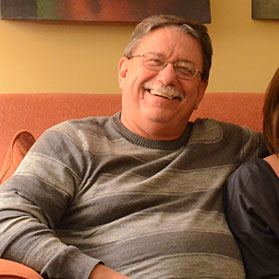A Winter Wake-Up Call

For Warren Schulte, 53, waking up in the hospital after cardiac arrest that could have taken his life was a wake-up call. “My big deal is, I knew my cholesterol was not perfect, but I didn’t go back to the heart doctor. The thing I tell people now is, just go to the doctor.”
Warren is an active, physical guy. He’s a project manager for a small electrical contractor and is often “at the worksite, getting my tools out,” he explains. One Saturday just after New Years, he was helping his daughter with a project in her basement. When he came home, he was not feeling well. His chest hurt, his stomach was upset, and he was lightheaded. His wife Cathy asked, “Is it chest pain? Do we need to take you to the hospital?” “No.”
Immediate Intervention Saves Warren's Life
Unfortunately, within 30 minutes Warren had collapsed and was unresponsive. Cathy made a frantic call to 911, and with calm professionalism, Hamilton County dispatcher Kristie Veldkamp coaxed out of Cathy what she needed to know: an address – and the fact that Warren was not breathing. This allowed her to send the right help, quickly. Paramedics from the Colerain Township Department of Fire and EMS arrived in about three-and-a-half minutes.
The team went to work with medications, CPR and shocks with an external defibrillator to attempt to restart his heart, and after nine minutes they got a pulse. They gave the family options on where to transport him, but then the paramedic said, “If it were my dad, I’d go to Good Sam.” That was all the family needed to hear. The paramedics raced to Good Samaritan Hospital where staff was ready for him. A speedy EKG confirmed that the cardiac arrest had been caused by a heart attack.
The staff started a hypothermia protocol, using a machine to reduce his body temperature to 91.4 degrees and hold it there for 24 hours. This reduces the body’s need for oxygen and can stem potential damage to the brain. Then Warren was rushed to the cath lab where Craig Sukin MD, was waiting to open the blockage that was causing the heart attack. Dr. Sukin found that the main artery to Warren’s heart was 100-percent blocked, and after clearing the blockage, Dr. Sukin placed a small device called a stent in the artery to keep it open.
Getting Warren Back to Work
While the heart procedure was successful, Warren was not out of the woods. Having lost oxygen for a period of time, there was no way of knowing what his brain function would be when he awoke. His family waited several agonizing days for him to move through the cooling and rewarming period. When he woke up, he had no short-term memory, but could converse with people about things that had happened in the past. But 11 days later, Warren walked out of the hospital and stepped back into his life. A month later, he was back at work and faithfully attending cardiac rehab.
“Everyone who took care of Warren at Good Samaritan was terrific,” Cathy concludes. “Joni Zinser in the CCU was wonderful; she explained everything to us. The chaplain, Dennis Romans, never left us during that first night in Emergency. He was a kind, kind man.”
Cathy adds, “It was extremely overwhelming. We have a lot of faith. God put all the pieces together. God was right there and let all the pieces fall in place.”
As for Warren, he doesn’t remember much about the ordeal, but he does know this: With a strong family history of heart disease and this wake up call, he’ll be talking with his children and other family members about paying more attention to their heart health. Now he understands the consequences of ignoring it.